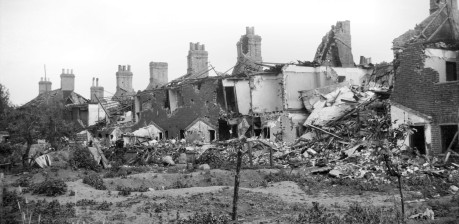 Although quite a
number of raids were carried out on the city of Norwich
in this year, damage to property was mostly confined to residential
areas. Many of the raids were at night or in the
early morning, but the most damaging visitations, and
those that caused many of the casualties, took place in
the afternoon or early evening. Although quite a
number of raids were carried out on the city of Norwich
in this year, damage to property was mostly confined to residential
areas. Many of the raids were at night or in the
early morning, but the most damaging visitations, and
those that caused many of the casualties, took place in
the afternoon or early evening.The city's death-roll
for the year amounted to sixty-one, of whom twenty-six
were killed on the 9th July during the first raid which
Norwich sustained.
9th July, 1940.
At about 5pm eleven bombs of the whistling type were
dropped by a Dornier 17 and a Junkers 88; they included
several incendiaries which fired part of a warehouse on
the Salhouse Road (just beyond the city boundary) and
high explosives which fell both on Boulton and Paul's
Riverside Works and on Carrow Hill.
|
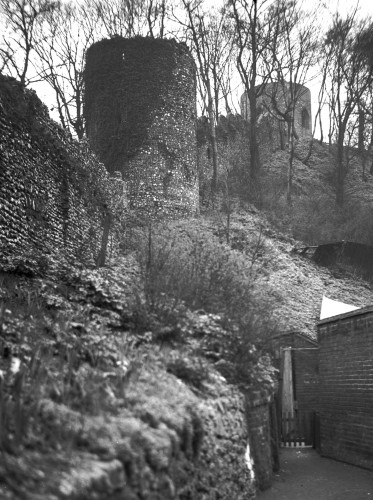 At the latter
place some 40 feet of the old City Wall east of the Wilderness
Tower (left) was blown down. The most serious
aspect of this raid was the high casualty list - due to
the incident coinciding with the time at which Colman's
employees were leaving work for the day, and the fact
that no air-raid warning had been given. At the latter
place some 40 feet of the old City Wall east of the Wilderness
Tower (left) was blown down. The most serious
aspect of this raid was the high casualty list - due to
the incident coinciding with the time at which Colman's
employees were leaving work for the day, and the fact
that no air-raid warning had been given.19th July, 1940. At about
6.15am a lone enemy raider dropped a stick of bombs which
damaged or destroyed the following places- 78-80, Bull
Close Road; the garage of the Cat and Fiddle
inn, Magdalen Street; 33-35, Botolph Street; 172, St
George Street; 45-47, Pitt Street; and (by fire) the
Norwich Aero Club rooms just beyond the city near
Heartsease Lane. Although the sirens were not sounded,
there was but one casualty - an old lady who was taken to
hospital and died some days later.
30th July, 1940.
At about 6am a number of bombs dropped by a single enemy
raider caused some damage and casualties, Victoria
Terrace, Pegg's Opening, being the scene of several
deaths, as four or five of the houses collapsed and there
had been no warning sounded. Other places involved
included the printing works at Colman's; houses in Argyle
Street and Compass Street; 68, Ber Street; the Omnibus
Station, Surrey Street; and in front of 25-27,
Surrey Street (below). The portico of the
last-mentioned place was blown to pieces, but as it
possessed some historic and artistic interest the
fragments were collected together with the hope of
effecting a restoration after the war. Unfortunately they
were destroyed by fire in a later raid as they lay in the
builder's yard.
|
 1st August, 1940. At about
3.15pm a single enemy raider dropped bombs which fell at
Boulton and Paul's Riverside Works, causing a great blaze
in the Joinery department and the office. The first
incendiaries to fall within the city boundary were
dropped during this raid. Several workmen and others were
killed. Many windows were broken around by King Street
and Foundry Bridge, and before leaving the raider
machine-gunned the streets. No warning was given. It was
subsequently announced, both by the BBC and in the Press,
that Norwich had been attacked. With the exception of an
air attack on Dover harbour, no newspaper until this time
had been permitted to divulge the name of any town or
city raided. 1st August, 1940. At about
3.15pm a single enemy raider dropped bombs which fell at
Boulton and Paul's Riverside Works, causing a great blaze
in the Joinery department and the office. The first
incendiaries to fall within the city boundary were
dropped during this raid. Several workmen and others were
killed. Many windows were broken around by King Street
and Foundry Bridge, and before leaving the raider
machine-gunned the streets. No warning was given. It was
subsequently announced, both by the BBC and in the Press,
that Norwich had been attacked. With the exception of an
air attack on Dover harbour, no newspaper until this time
had been permitted to divulge the name of any town or
city raided.On the 2nd August, 1940, a deputation from
the Norwich City Council met representatives of the
Ministry of Home Security in London regarding the
sounding of sirens whenever an air attack upon the city
seemed imminent, and urged that the system of air raid
warnings should be adjusted so as to make this possible.
The deputation was assured that active and urgent
consideration was being given to the matters which they
had put forward, and that adjustments would be made in
the light of experience.
10th August, 1940.
Just after 6pm three bombs were dropped on the city, one
falling upon a timber shed at Carrow Works. Little damage
was caused.
20th August, 1940.
At about 6am a number of incendiary bombs were dropped,
falling in Surrey Street; Davey Place; outside the
Guildhall and at the Home and Colonial Stores, 40a,
Magdalen Street. The latter shop suffered most, with a
shattered plate glass window, some of the contents being
destroyed. Damage otherwise was negligible.
|
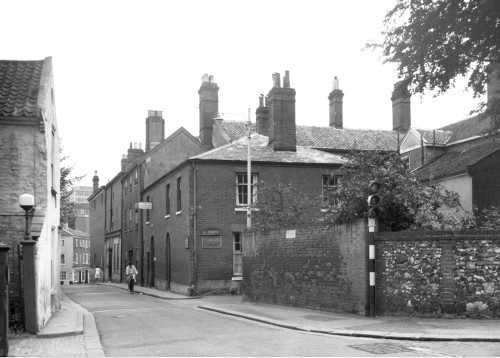 19th September, 1940. In the
early hours of the morning a bomb fell at the narrowest
part of Theatre Street (left), but fortunately
failed to explode. It embedded itself in the path against
No.4, sinking deeply into the soft subsoil. People were
evacuated from the immediate vicinity until its removal
five days later by the disposal squad. Digging took place
for the best part of a day before the tail was sighted,
after which came the delicate task of unearthing the rest
of the bomb, removing the fuses and hauling the missile
out of the crater. It was then conveyed to Harford tip
for investigation. 19th September, 1940. In the
early hours of the morning a bomb fell at the narrowest
part of Theatre Street (left), but fortunately
failed to explode. It embedded itself in the path against
No.4, sinking deeply into the soft subsoil. People were
evacuated from the immediate vicinity until its removal
five days later by the disposal squad. Digging took place
for the best part of a day before the tail was sighted,
after which came the delicate task of unearthing the rest
of the bomb, removing the fuses and hauling the missile
out of the crater. It was then conveyed to Harford tip
for investigation.At the same time as the above
incident, a search was conducted in the gardens of the
Bishop's Palace following statements which suggested that
a bomb might have fallen there. The investigation centred
upon a disused well, formerly covered in, which was
located about ten yards from the north transept of the
Cathedral. Excavations to a depth of nearly thirty feet
were made without any sign being discovered that was
suggestive of a bomb having fallen there.
27th October, 1940.
At about 6pm a number of high-explosive bombs fell around
the outskirts of Norwich. A bungalow in Orchard Close and
another in Furze Road were demolished.
|
 1st November, 1940. Three
incendiary bombs were dropped in the Larkman Lane area
but only very minor damage was caused. 1st November, 1940. Three
incendiary bombs were dropped in the Larkman Lane area
but only very minor damage was caused.11th November, 1940. Several
incendiary bombs fell in the early hours of the morning
causing small fires in the Thorpe Hamlet district, but
all were extinguished with little difficulty.
2nd December, 1940.
Just before 6pm bombs from an enemy aircraft fell in
Norwich, demolishing 49, St John Street and 49,
Bracondale. Damage was also caused to the Orchard Tavern,
38, Mountergate. A bomb which fell in the Cloister
Garth (right) of the Cathedral did no damage
beyond shattering some modern glass. There were several
fatal casualties.
11th December, 1940
(early). A single enemy aircraft dropped bombs
at the foot of Carrow Hill, demolishing 10, Dunston
Cottages. One of the occupants was killed and another
injured.
21st December, 1940 (at
night). A high explosive bomb was dropped in
Rye Avenue, Mile Cross. It fractured the water and gas
mains and broke a number of windows, but caused no
casualties.
|
| Although during this year Norwich was not subjected
to any sustained attack, material damage was greater than
in 1940 when the raids covered roughly a similar period.
The casualty list however was considerably smaller.
Twenty people were killed and twenty-eight injured. Only
two of the attacks were made in daylight. They were of
the hit-and-run type, carried out by single raiders that
approached the city under cover of heavy cloud. |
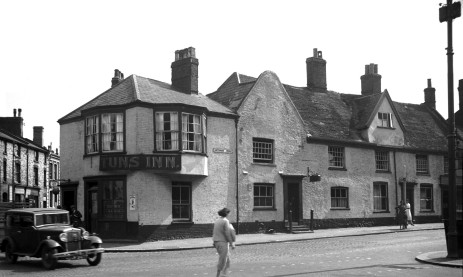 5th January, 1941. At about
10.30am an enemy raider dived from clouds to drop a
number of bombs on the outskirts of Norwich. They fell on
Eaton Golf Course and the City of Norwich School playing
fields but did no material damage. The Unthank
Road district (left) was afterwards
machine-gunned but the only result was a number of
smashed tiles and windows. 5th January, 1941. At about
10.30am an enemy raider dived from clouds to drop a
number of bombs on the outskirts of Norwich. They fell on
Eaton Golf Course and the City of Norwich School playing
fields but did no material damage. The Unthank
Road district (left) was afterwards
machine-gunned but the only result was a number of
smashed tiles and windows.4th
February, 1941. Bombs fell during the night
damaging Boulton and Paul's Riverside Works, and at
Plumstead Road damaging a number of houses and bungalows.
Two persons were killed and a few injured.
18th February, 1941.
A single raider caused considerable damage when it
dropped a heavy bomb of the whistling type at Vauxhall
Street at about 5.15am Many houses, shops and other
business, premises were destroyed and eight people were
killed and 12 injured.
27th February, 1941.
During the morning several bombs were dropped on
Barnard's factory, Salhouse Road. Some damage was caused
to the building but there were no casualties.
|
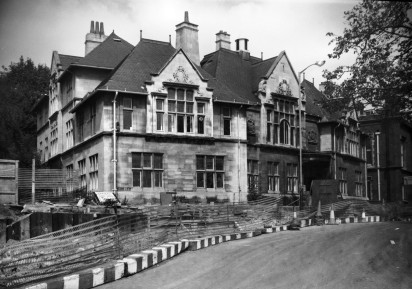 14th March, 1941. Thirty or
forty incendiary bombs which were dropped by enemy
aircraft during the night in the St Benedict's Street
area did little damage, through the alertness of street
firewatchers and others. One bomb lodged on the roof of
St Swithin's Church but although it melted the lead it
was extinguished before the roof timbers were set ablaze.
The most serious damage was to a private garage and car. 14th March, 1941. Thirty or
forty incendiary bombs which were dropped by enemy
aircraft during the night in the St Benedict's Street
area did little damage, through the alertness of street
firewatchers and others. One bomb lodged on the roof of
St Swithin's Church but although it melted the lead it
was extinguished before the roof timbers were set ablaze.
The most serious damage was to a private garage and car.30th March, 1941.
Bombs dropped during the night by an enemy aircraft did
little damage. They fell on Caernarvon Road and at the
back of 130, Earlham Road occupied by Mr W.J.Finch, then
Sheriff of Norwich. Nobody was injured but one of the
occupants at the latter address had to be dug out of the
wreckage.
2nd April, 1941.
A number of heavy bombs were dropped in the Riverside
district during the afternoon, killing one of Steward and
Patteson's draymen whilst at work. The raider also
machine-gunned houses and other buildings, but little
material damage was caused. A party of workmen escaped
unscathed when a bomb fell fifteen yards from a surface
shelter in which they had just taken refuge. A large
fragment of bomb crashed through the roof of the Shirehall
(right) and fell into the courtroom during a Quarter
Sessions sitting but nobody was hurt.
|
 29th April 1941. High
explosive bombs of varied calibre, oil bombs and other
incendiaries were dropped during the night by a raider
whose chief target was the extensive works of Colman's
(left) where several mills were burnt out. Of eight
casualties only one was fatal. With three major fires
raging at the same time the services were hampered by a
series of misfortunes. A water main was fractured; a
building collapsed into the river at a point from which
water was being taken, and roads which the services would
normally use were blocked. 29th April 1941. High
explosive bombs of varied calibre, oil bombs and other
incendiaries were dropped during the night by a raider
whose chief target was the extensive works of Colman's
(left) where several mills were burnt out. Of eight
casualties only one was fatal. With three major fires
raging at the same time the services were hampered by a
series of misfortunes. A water main was fractured; a
building collapsed into the river at a point from which
water was being taken, and roads which the services would
normally use were blocked.5th
May, 1941. Enemy aircraft dropped high
explosive bombs during the night which destroyed some
houses in Bury Street and blew out the fronts of other
houses on Unthank Road. At the same time a few
incendiaries were dropped in another part of the city,
one falling on the roof of St Michael at Pleas Church,
but the fire was extinguished before any serious damage
was done. There were several casualties, three of which
were fatal.
7th May, 1941.
During the night bombs were dropped on the Larkman Lane
Estate killing a Mr and Mrs Britcher and three of their
six children. The other three had to be taken to
hospital. Although many other houses were damaged only
one other person was detained in hospital. A newly
erected school on this estate and a Mission Church also
suffered.
10th May, 1941.
At about 2.30am five bombs were dropped in a line in the
Cecil Road area; there were no serious casualties. A flat
in Lady Betty Road was demolished by a direct hit, and
houses in Cecil Road were damaged by a bomb which fell
near the A.R.P. post at the junction with Grove Walk.
Another fell at the rear of the house of Mr Clifford
White (Sheriff 1941-42).
|
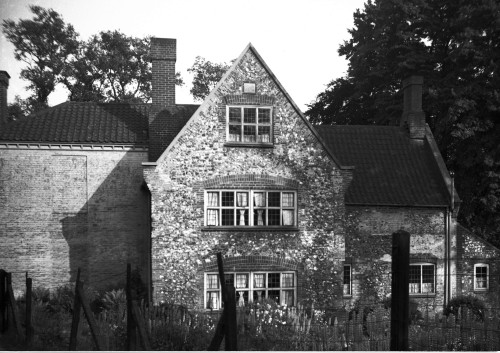 17th May, 1941. At about 1am
two heavy bombs were dropped at Old Lakenham, a short
distance from the Lakenham Baths, and the Villa
Gardens, Martineau Lane (right). Although the
walls of the house withstood the terrific blast, many
windows were broken and the tiles were stripped from the
roof, some of the timbers of which collapsed. 17th May, 1941. At about 1am
two heavy bombs were dropped at Old Lakenham, a short
distance from the Lakenham Baths, and the Villa
Gardens, Martineau Lane (right). Although the
walls of the house withstood the terrific blast, many
windows were broken and the tiles were stripped from the
roof, some of the timbers of which collapsed.Furniture
in every one of the eleven rooms was twisted and broken
but in spite of this nobody was killed and only three
people required hospital treatment. The panelling from
one of the upper rooms of this house (which dated from
the early 17th century) had for a number of years been
preserved in the Keep of the Castle Museum. During the
same incident several semidetached houses on the nearby
Long John Hill also sustained considerable damage.
30th July, 1941.
A stick of bombs was dropped near Marl Pit Lane, Dereham
Road during the early hours of the morning. Apart from
the uprooting of a tree no material damage was done.
8th August, 1941.
Late at night eight bombs were dropped near Church Farm,
Eaton, but failed to explode.
From this date until the heavy raid on the city of the
27th April, 1942, Norwich enjoyed a period of quiescence;
a good many air raid warnings were sounded throughout
this time but no incidents of note occurred.
Bombed by enemy aircraft on some twenty-seven
occasions during the period dealt with above, Norwich
suffered hardly any damage throughout that time in-so-far
as its antiquities were concerned. The majority of the
raids were carried out by single enemy aircraft - those
that came during daylight hours approaching the city
under cover of heavy cloud. The brunt of these attacks
was borne by houses and shops.
|
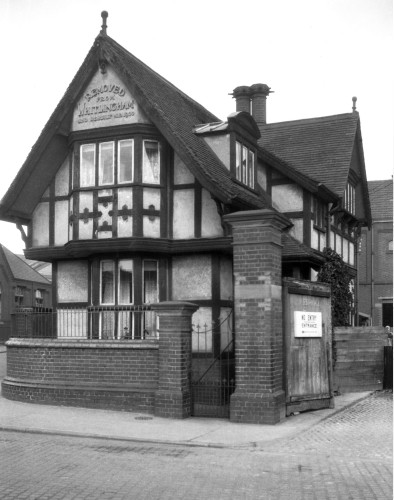 As already
mentioned the period of quiescence which commenced in the
middle of 1941 was rudely shattered on April 27th of the
following year by the first of the several blitz
raids which the city was to endure. The second followed
in rapid succession two nights later, with a third on
June 27th and a fourth on August 2nd. Incendiary bombs
accounted for a large proportion of the damage done
during the latter occasions. The total number of
casualties for the year amounted to over 250 killed and
many hundreds injured to a greater or less degree. As already
mentioned the period of quiescence which commenced in the
middle of 1941 was rudely shattered on April 27th of the
following year by the first of the several blitz
raids which the city was to endure. The second followed
in rapid succession two nights later, with a third on
June 27th and a fourth on August 2nd. Incendiary bombs
accounted for a large proportion of the damage done
during the latter occasions. The total number of
casualties for the year amounted to over 250 killed and
many hundreds injured to a greater or less degree.Equally
vicious raids were being carried out at the same time
upon such towns as Exeter, Bath, Canterbury and York,
which, like Norwich, could hardly be counted as military
objectives. Indeed it appears that they were deliberately
selected from the famous Baedeker Guidebooks in which
they were starred as cultural centres containing
many places of historic and archaeological importance,
and bombed as a direct response to Britain's bombing of
the historic German city of Luebeck on March 28.
27th April, 1942 (at
night). Considerable and widespread damage was
done in various districts, mainly in working-class and
residential areas, during a raid which lasted for well
over an hour and which commenced with the release of many
flares over the town. Anti- aircraft fire was not
particularly heavy but this was apparently due to the
pressure of R.A.F. night fighters whose machine-guns were
heard.
Tracer bullets were also seen. Several hundreds of
small houses, new and old, were more or less heavily
damaged, but as the raiders concentrated more upon the
residential areas rather than the city proper, the
majority of the famous old buildings of Norwich escaped
serious damage.
|
 Unfortunately,
for the same reason (and also no doubt because of the
long preceding period of quiescence) casualties were
heavy, 162 being killed (including firewatchers,
ambulance men and a Home Guard) with over 400 people
being injured. Unfortunately,
for the same reason (and also no doubt because of the
long preceding period of quiescence) casualties were
heavy, 162 being killed (including firewatchers,
ambulance men and a Home Guard) with over 400 people
being injured.From the heavily attacked areas many
made their way at the height of the raid for shelters on
the outskirts of the city. With bombs screaming down on
all sides, firemen worked feverishly to control the
conflagrations. Five units from neighbouring towns
assisted the Norwich Fire Service. One of the worst hit
areas was that of Heigham Street, the Westwick
Depot (above) being one of the many buildings in
that district which were reduced to a mass of rubble. The
firewatchers there were killed.
The former Orchard Tavern (right) was also
destroyed.
|
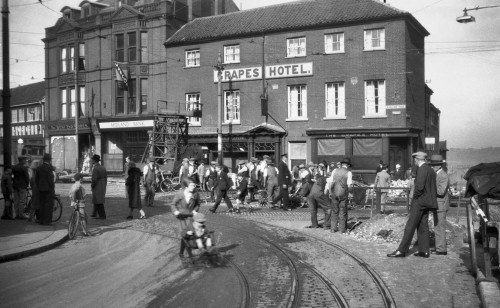 Much of St
Augustine's School was wrecked; the Norwich Institution
for the Blind was damaged by the same stick of bombs
which wrecked the roof of the Odeon Cinema in Botolph
Street. The Public Assistance Institution on Bowthorpe
Road received direct hits from both high explosives and
incendiaries, but many of the inmates were in the shelter
at the time and unhurt. Much of St
Augustine's School was wrecked; the Norwich Institution
for the Blind was damaged by the same stick of bombs
which wrecked the roof of the Odeon Cinema in Botolph
Street. The Public Assistance Institution on Bowthorpe
Road received direct hits from both high explosives and
incendiaries, but many of the inmates were in the shelter
at the time and unhurt.The upper floors of the Grapes
Hotel (left), a late Georgian house by St Giles'
Gate, were gutted.
But it is useless to record odd incidents - a page
could be filled merely by listing the names of the places
which were either destroyed or damaged in varying
degrees. In all parts of the areas attacked the scene was
the same on the following day - houses and shops
demolished or severely damaged, and the streets deep in
broken glass, tiles and masonry.
|
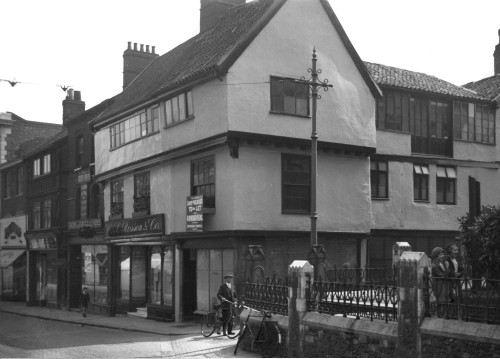 At a number of
points digging was proceeding for trapped people and many
families, soot-covered but free of injury, were rescuing
what they could of their belongings. It has been
estimated that 185 heavy bombs of a total weight of over
50 tons were dropped on this occasion. At a number of
points digging was proceeding for trapped people and many
families, soot-covered but free of injury, were rescuing
what they could of their belongings. It has been
estimated that 185 heavy bombs of a total weight of over
50 tons were dropped on this occasion.29th April, 1942 (at night).
Norwich was still in the first stage of its efforts
towards restoring some sort of order after the sharp
attack made by the enemy during the night of the 27th
when on the Wednesday it was again the target for a reprisal
raid.
This time the people were ready for it, and
practically every family went under cover. Anderson,
Morrison and street shelters must have saved the lives of
hundreds of the inhabitants of working and middle-class
houses during the re-enactment of Monday night's scenes
in different parts of the city. Incendiaries caused much
of the damage - one of the largest areas affected in this
manner incorporating Curls' department store at Orford
Place, and both sides of Rampant Horse Street (right)
as far as but not including St Stephen's Church.
|
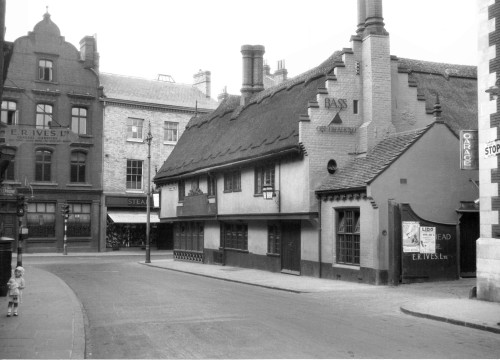 Part of St
Stephen's Street with the famous old Boar's Head
inn (left), Barwell's, Peacock's, and beyond
that several of the large factory buildings of Caley's
were also involved. Part of St
Stephen's Street with the famous old Boar's Head
inn (left), Barwell's, Peacock's, and beyond
that several of the large factory buildings of Caley's
were also involved.A warm tribute was paid to the
Norwich people for the way in which they stood up to
their grim ordeal, and to the Civil Defence Services, the
Town Clerk and his department, the Chief Constable, the
Fire Service, and all auxiliary services, by
Messrs.Shakespeare and Strauss, the city's Members of
Parliament, who also expressed admiration for the way in
which the matrons of the various hospitals had evacuated
patients to the basements.
During this, the second heavy attack on Norwich, it
was estimated that 45 tons of bombs were dropped,
including 112 high explosives and numerous incendiaries.
The death-roll amounted to 69 and there were 89 seriously
injured. Public funerals of many of the victims of both
raids took place at the Norwich Cemetery on the 4th, 5th
and 7th of May. The Bishop of Norwich, the Dean, the Lord
Mayor and other notabilities attended the first of these
ceremonies, and the address was given by Dr Gilbert Laws
of St Mary's Baptist Church.
|
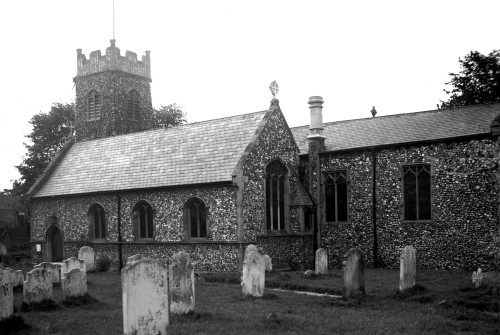 Amongst the
other losses of the 27th and 29th April were the churches
of St Bartholomew in Heigham (right)
and St Benedicts (below); and parts of Oak St, Pitt St, St George's St, Gildencroft, St Benedict's St, Wellington Lane and Westwick St. Amongst the
other losses of the 27th and 29th April were the churches
of St Bartholomew in Heigham (right)
and St Benedicts (below); and parts of Oak St, Pitt St, St George's St, Gildencroft, St Benedict's St, Wellington Lane and Westwick St.1st May, 1942. In the
early hours of the morning many incendiaries were
dropped, chiefly in Heigham Street, Duke Street and St
Andrew's Street.
9th May, 1942.
Enemy raiders who were over Eastern England during the
early hours of the morning scattered their bombs over a
wide area, many being dropped at the village of Stoke
Holy Cross about three miles south of Norwich, although
one was also dropped upon the boiler house of the Norwich
Public Assistance Institution, injuring nobody. The
aircraft were cruising in the vicinity for a considerable
period, and were obviously harassed by the heavy
anti-aircraft barrage. Two were eventually destroyed. One
in East Anglia and the other near its base in Holland.
[Editor's note added 03/2020 from information received: A Heinkel 111 from the raid was shot down by a night-fighter from 219 Squadron based at Tangmere. It hit a power line on the way down and broke up. The crew of 5 are buried in Brighton City Cemetery.]
|
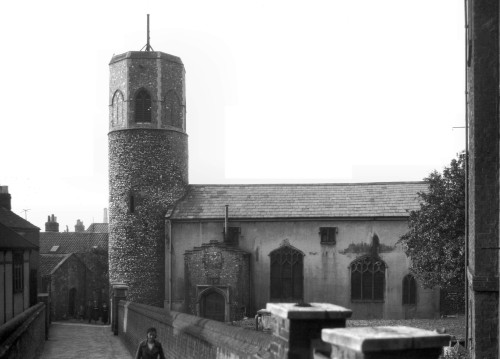 On 26th May,
1942 a visit to Norwich was paid by the Duke of Kent who
made an extensive tour of the damaged areas. He visited
the Norfolk and Norwich Hospital where he talked to
several victims and also the Norwich Institution for the
Blind. The tour began with an inspection in front of the
City Hall of members of the Home Guard, and Civil Defence
Workers. Subsequently the Lord Mayor (Mr J.H.Barnes)
received a letter from the Duke expressing his sorrow at
the extensive nature of the damage suffered by the city,
but stating how he had been impressed by the courage and
fortitude of the inhabitants in such difficult times. On 26th May,
1942 a visit to Norwich was paid by the Duke of Kent who
made an extensive tour of the damaged areas. He visited
the Norfolk and Norwich Hospital where he talked to
several victims and also the Norwich Institution for the
Blind. The tour began with an inspection in front of the
City Hall of members of the Home Guard, and Civil Defence
Workers. Subsequently the Lord Mayor (Mr J.H.Barnes)
received a letter from the Duke expressing his sorrow at
the extensive nature of the damage suffered by the city,
but stating how he had been impressed by the courage and
fortitude of the inhabitants in such difficult times. |
 27th June, 1942. Three enemy
aircraft were destroyed when a small number of planes
crossed the east coast in the moonlight of the early
morning to attack Norwich for about an hour. Flares lit
up the sky and incendiaries and high explosives were
dropped which started several big fires. 27th June, 1942. Three enemy
aircraft were destroyed when a small number of planes
crossed the east coast in the moonlight of the early
morning to attack Norwich for about an hour. Flares lit
up the sky and incendiaries and high explosives were
dropped which started several big fires.Four wards of
the Norfolk and Norwich Hospital, the main operating
theatre, the Leicester Nurses' Home, as well as two
smaller residences occupied by the staff, formed one of
the major conflagrations, whilst not far off the large
stores of Bonds of All Saints Green and Ber St, together with
the Thatched Assembly Rooms (right)
suffering a similar fate.
|
 A
determined attack was made upon the Cathedral, around
which no less than 850 incendiaries were showered, but
owing to the efforts of the firewatchers and to the fact
that the whole of the inside roofing is a vault of brick
and stone, the only damage suffered here was to the roofs
of the north and south transepts where some of the lead
was melted and the timbers burnt. Two or three old houses
in The Close were
gutted however, including the Audit Chamber and one of
the Grammar School blocks. A
determined attack was made upon the Cathedral, around
which no less than 850 incendiaries were showered, but
owing to the efforts of the firewatchers and to the fact
that the whole of the inside roofing is a vault of brick
and stone, the only damage suffered here was to the roofs
of the north and south transepts where some of the lead
was melted and the timbers burnt. Two or three old houses
in The Close were
gutted however, including the Audit Chamber and one of
the Grammar School blocks.Archaeologically, Norwich
lost more in this than in any previous raid.
Ecclesiastical buildings which suffered were the church
of St Michael at Thorn in Ber Street, and of St Paul's,
both of which were burned out.
St Julian's Church in King Street (left)
had almost everything excepting its north wall and porch
completely annihilated by a high explosive bomb.
|
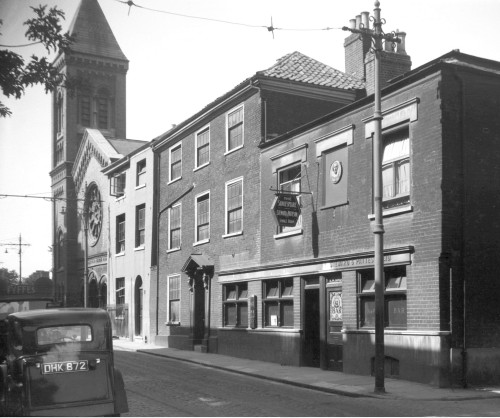 St Mary's Plain
Baptist Church, which was accidentally burned a few days
after the beginning of the war and had since been
restored, was again gutted - this time hopelessly so, and
with its adjoining schoolrooms; and similar fates were
suffered by the sacristy of St George's Roman Catholic
Church in Fishergate; by the Trinity Presbyterian
Church in Theatre Street (right); and the
Synagogue in the street of that name. St Mary's Plain
Baptist Church, which was accidentally burned a few days
after the beginning of the war and had since been
restored, was again gutted - this time hopelessly so, and
with its adjoining schoolrooms; and similar fates were
suffered by the sacristy of St George's Roman Catholic
Church in Fishergate; by the Trinity Presbyterian
Church in Theatre Street (right); and the
Synagogue in the street of that name.Other buildings
attacked and burnt included 20 Timberhill formerly
the Star and Crown PH. 70 and Kett's at 72 St Giles
Street (below) were similarly lost; as was Heigham Grove House,
the City Maternity Home just beyond St Giles' Gate on the
south side of Earlham Road.
Although a considerable part of Morgan's brewery in
King Street was badly damaged, their offices in the 17th
century Howard House came through almost unscathed.
|
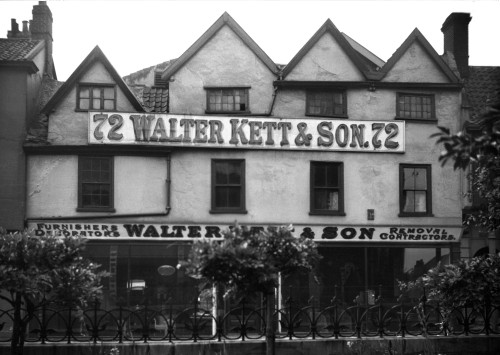 In addition to
all this, extensive damage to houses and business
premises was caused (a total of 34 high explosives and
literally thousands of incendiaries were dropped during
the raid) but casualties were fortunately comparatively
light - sixteen people being killed and fifteen seriously
injured. Some of the raiders narrowly missed the
housetops in diving to their objectives; there was heavy
anti-aircraft fire and night fighters were busy. In addition to
all this, extensive damage to houses and business
premises was caused (a total of 34 high explosives and
literally thousands of incendiaries were dropped during
the raid) but casualties were fortunately comparatively
light - sixteen people being killed and fifteen seriously
injured. Some of the raiders narrowly missed the
housetops in diving to their objectives; there was heavy
anti-aircraft fire and night fighters were busy.One of
the three raiders destroyed was a JU 88, shot down by a
D.F.C.Squadron Leader flying a Spitfire; the JU was
sighted by the pilot ten miles off the coast. Both
aircraft opened fire but the German soon abandoned the
fight for evasive tactics. Five quick attacks were made
by the Squadron Leader with cannon and machine-gun fire
and after the third burst the JU 88, with pieces falling
from it, dived towards the sea. Suddenly it began to
climb again, so the Spitfire pilot, closing to one
hundred yards, fired two more bursts. There was a
blinding flash and the JU went straight into the sea.
|
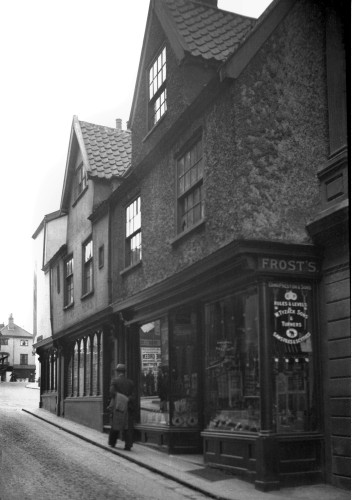 28th July, 1942. In the early
hours of the morning enemy raiders unloaded a shower of
incendiary bombs over the St Benedict's area of Norwich,
the most serious of the resulting fires being at Bretts
of 15, St Benedict's Street, where the top storeys were
burnt out and stock of considerable value was damaged
both by fire and water. It was some time before the blaze
could be brought under control. 28th July, 1942. In the early
hours of the morning enemy raiders unloaded a shower of
incendiary bombs over the St Benedict's area of Norwich,
the most serious of the resulting fires being at Bretts
of 15, St Benedict's Street, where the top storeys were
burnt out and stock of considerable value was damaged
both by fire and water. It was some time before the blaze
could be brought under control.Nearby, the lecture
hall of the Independent Labour Party's premises at St
Gregory's Alley was badly damaged and the sleeping
quarters of the brewer at Bullards in Coslany Street were
destroyed. In the same raid a plane believed to be a
fighter-bomber released its missile so that it fell in
the back garden of a house in Rowington Road.
Some of the houses whose doors and windows were
shattered by the blast had been similarly damaged on
three previous occasions. A wooden building used by Boy
Scouts was demolished and the debris from it, together
with a big shower of earth and stones from the very large
crater, was scattered over a wide area. Most of the
residents took shelter and there were no casualties.
2nd August, 1942.
A small number of enemy raiders made another attack on
Norwich early in the morning and showered incendiary
bombs as well as a few high explosives during the course
of a short sharp raid. Several fires were started, mainly
in business premises, and there were five fatal
casualties. Trevor Page, the house furnishers, had their
premises in St John Maddermarket as well as on one side
of Exchange Street largely destroyed by fire, and in the
same block Back's wine shop (Exchange Street) and Frost's
tool shop (Lobster Lane) (right) were also
involved. In St George Street the upper part of the rear
of the extensive premises of Gunton Sons and Dyball,
ironmongers was fired, and here a caretaker was trapped
in a lift and subsequently died.
|
 At St Mary's
Plain a considerable part of the factory of Sexton Sons
and Everard was gutted and the ancient thatched house
formerly the Rosemary tavern had its thatch destroyed and
upper storey damaged. Two old people, both blind and one
also deaf, were rescued from here. At St Mary's
Plain a considerable part of the factory of Sexton Sons
and Everard was gutted and the ancient thatched house
formerly the Rosemary tavern had its thatch destroyed and
upper storey damaged. Two old people, both blind and one
also deaf, were rescued from here.Another boot and
shoe factory in a different part of the city which was
also burned out was Hurrell's of 96 to 100 Magdalen
Street (left). Their offices were housed in a fine
old Georgian mansion, the front of which had been
modernised early in the 20th century. The residential
district of Napier Street, which had already suffered
badly in the April raids, was hit once again by a number
of high explosives, and several families were rendered
homeless.
13th August, 1942.
A small number of enemy aircraft unloaded their bombs on
the city during the night, causing only slight damage and
no casualties. The raiders, which first dropped flares,
were harried by fighters and subjected to heavy fire from
ground defences.
A number of high explosive bombs which fell in a
working-class district caused damage to Mousehold Avenue
Infants School as well as to some houses nearby, but many
fire bombs which also dropped in the vicinity of houses
on the outskirts of the town burned themselves out
harmlessly in fields and gardens.
|
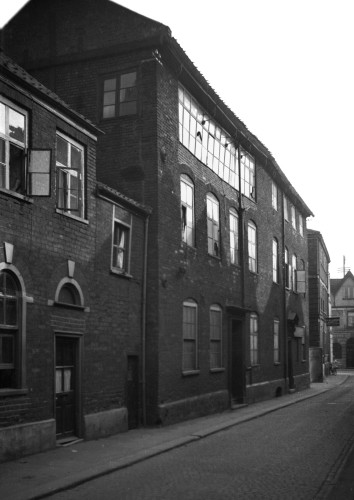 5th September, 1942. Five
people were killed and a number of injured had to be
admitted to hospital when, during the morning, a
high-flying raider dropped a number of high-explosive
bombs on either side of Magdalen Street - a busy shopping
centre in Norwich. Many women with their baskets rushed
for safety whilst others gazed up to the sky. 5th September, 1942. Five
people were killed and a number of injured had to be
admitted to hospital when, during the morning, a
high-flying raider dropped a number of high-explosive
bombs on either side of Magdalen Street - a busy shopping
centre in Norwich. Many women with their baskets rushed
for safety whilst others gazed up to the sky.The whole
incident was over in a matter of seconds. Among buildings
hit were the engine room of Frazer's Joinery Works at St
Martin at Palace Plain, and Batson and Webster's factory
at Fishergate (where were most of the casualties). The
remainder of the stick fell in a back garden at
the rear of Boots the chemists in Magdalen Street (close
by the Old Meeting House) and in the centre of an old
house – 3, Calvert Street (right) -
which had been gutted by fire in a former raid.
Ancient dwellings on the opposite side of
Calvert street (below) were also considerably
shaken.
On the 12th October, 1942, His Majesty the King paid a
surprise visit to the city in order to see at first hand
the extent to which Norwich had suffered during air
raids, and to inspect members of the Civil Defence
Services who had done commendable work during and after
the attacks. Several hundreds of men, women and boys,
representing a score of branches of the Civil Defence
Services, paraded outside the City Hall. So well had the
secret of the visit been kept however, that few of them
were aware that it was the King himself who was to make
the inspection. During a 25 mile tour of the city His
Majesty visited the Norfolk and Norwich Hospital, the
Cathedral and the Services' Club. Accompanied by the Lord
Mayor (Mr J.H.Barnes) he motored through no fewer than
forty-eight different streets including some in which
extensive damage had been caused to residential property
by the raiders.
|
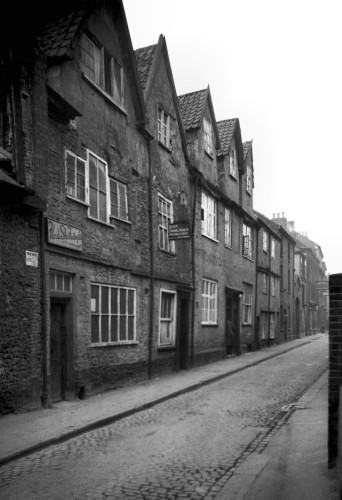 19th October, 1942. A Dornier
flew very low over the town at about 7.15am and dropped a
number of bombs in the Carrow-Thorpe district, which
exploded without causing damage or injury. Some
machine-gun fire took place both before and after the
incident. 19th October, 1942. A Dornier
flew very low over the town at about 7.15am and dropped a
number of bombs in the Carrow-Thorpe district, which
exploded without causing damage or injury. Some
machine-gun fire took place both before and after the
incident.19th October,
1942. At about 11am another raider dropped
some bombs on the city and certain damage to property was
caused. There was also one slight casualty. One of the
bombs which fell in the Jenny Lind Children's Playground,
Pottergate, demolished the end and part of the roof of
the small building used by the Seventh Day Adventists.
The shell of St Mary's Baptist Sunday Schoolrooms, burnt
out some months ago in a previous raid, was hit, as was
the building in Westwick Street adjoining St Lawrence's
Church to the west, used by Edwards and Holmes as a shoe
factory since the April raids when their works on Drayton
Road had been destroyed. The adjacent church of St
Margaret had its windows shattered and was otherwise
shaken by this bomb.
3rd November, 1942.
At about 8am a raider flew over Norwich and opened up
with its machine-gun. Bombs (all of which failed to
explode) were dropped in the Cattlemarket, All Saints
Green and at the Surrey Street 'Bus Station.
5th December, 1942.
Enemy aircraft flew over Norwich at about 1pm taking
advantage of the cover of low cloud. Anti-aircraft
defences and fighters went into action. A few bombs were
dropped by the Heartsease Inn but no damage was done.
|
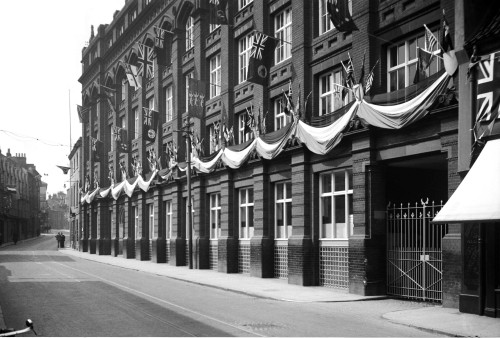 For this year we
have noted only five raids on the city during the course
of which bombs were dropped. All were on a comparatively
small scale although that of March 18th saw the
spectacular destruction of Harmer's
extensive clothing factory in St Andrew's Street
(pictured right for the Silver Jubilee in 1935). This
reduction of raids, both in regard to their size and
number, gave adequate proof (were any needed) of the fact
that the enemy were feeling the pinch in other
quarters and that the initiative had passed from their
control to ours. For this year we
have noted only five raids on the city during the course
of which bombs were dropped. All were on a comparatively
small scale although that of March 18th saw the
spectacular destruction of Harmer's
extensive clothing factory in St Andrew's Street
(pictured right for the Silver Jubilee in 1935). This
reduction of raids, both in regard to their size and
number, gave adequate proof (were any needed) of the fact
that the enemy were feeling the pinch in other
quarters and that the initiative had passed from their
control to ours.1st
January, 1943. During the afternoon an enemy
raider dropped a stick of bombs on North Heigham, a
congested area of small houses in Norwich which had
suffered in previous raids. Two houses collapsed and one
was partly wrecked by blast, but there were no casualties
as the inhabitants had all managed to reach their
shelters before the bombs fell. Another bomb tore a hole
in the south wall of St Barnabas Church, a building
erected early in the 20th century. The fine east window
lost several panes of glass and the roof was damaged. The
church schoolroom and a number of houses nearby also
suffered from blast. Other bombs which were dropped on
the outskirts of the town did little damage and hurt
nobody.
|
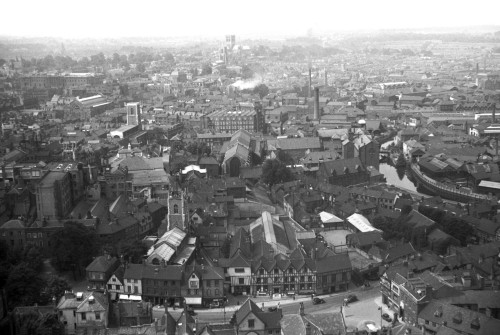 18th March, 1943. At about
10.30pm a small number of enemy planes became active over
a wide area of East Anglia. Flying singly, several of
them attacked Norwich and had to face a particularly
heavy barrage which only one or two succeeded in
penetrating. The remainder confined their attention to
the outskirts. High explosives and a large number of
incendiaries were showered on several localities and
there was some damage to civilian and business property
by blast and fire. Many of the bombs were of the
explosive canister type, throwing out phosphorous
projectiles which came to be known as flowerpots
among A.R.P. workers. 18th March, 1943. At about
10.30pm a small number of enemy planes became active over
a wide area of East Anglia. Flying singly, several of
them attacked Norwich and had to face a particularly
heavy barrage which only one or two succeeded in
penetrating. The remainder confined their attention to
the outskirts. High explosives and a large number of
incendiaries were showered on several localities and
there was some damage to civilian and business property
by blast and fire. Many of the bombs were of the
explosive canister type, throwing out phosphorous
projectiles which came to be known as flowerpots
among A.R.P. workers.The worst incident was
undoubtedly in St Andrew's Street (seen to the left in
this 1937 westerly view from the cathedral spire) where
the large clothing factory and warehouse of F.W.Harmer
was burned to the ground - a fate which might have been
shared by the new Telephone Exchange opposite had not its
windows been bricked up some time previously as a
precaution. Three persons had to be admitted to hospital,
one of them seriously hurt. Two houses on an out-lying
estate suffered from a direct hit by a bomb of the
canister type, which caused a fire, and there was similar
damage in other parts of the town - to a doctor's
residence and a public house. A pilot of a squadron which
had shot down at least thirty-six Nazi aircraft and
damaged many others was responsible for the destruction
in ten minutes of two of the three enemy machines which
were brought down during the course of this raid.
|
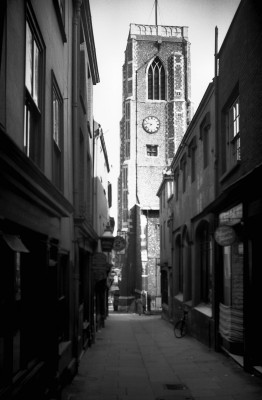 5th May, 1943. A small number
of enemy raiders were over East Anglia between the hours
of 3 and 4am They dropped incendiary bombs and a few high
explosives over a wide area. Some damage to property
resulted, but only three slight casualties were reported.
The main incidents were once again centred around St
Andrew's. The tower of St Andrew's parish church
(right) was struck by portions of a bomb which ripped off
the coping and started a fire in the priest's room above
the north porch. A baker's shop which stood in Bridewell
Alley within a few yards of the church was completely
destroyed and in nearby Queen Street the Cathedral
Restaurant and Bell's the estate agents' premises were
gutted by fire; Plowright's the antique dealers' premises
next door suffering severely from blast which scattered
and smashed a quantity of valuable silver and glassware.
Scores of fire bombs were also scattered over the Larkman
Lane and Hellesdon districts but such good work was done
by firewatchers and the N.F.S. who received a number of
calls, that damage to residential property was not
serious. 5th May, 1943. A small number
of enemy raiders were over East Anglia between the hours
of 3 and 4am They dropped incendiary bombs and a few high
explosives over a wide area. Some damage to property
resulted, but only three slight casualties were reported.
The main incidents were once again centred around St
Andrew's. The tower of St Andrew's parish church
(right) was struck by portions of a bomb which ripped off
the coping and started a fire in the priest's room above
the north porch. A baker's shop which stood in Bridewell
Alley within a few yards of the church was completely
destroyed and in nearby Queen Street the Cathedral
Restaurant and Bell's the estate agents' premises were
gutted by fire; Plowright's the antique dealers' premises
next door suffering severely from blast which scattered
and smashed a quantity of valuable silver and glassware.
Scores of fire bombs were also scattered over the Larkman
Lane and Hellesdon districts but such good work was done
by firewatchers and the N.F.S. who received a number of
calls, that damage to residential property was not
serious.7th October,
1943. In a small raid which took place during
the evening some high explosive bombs were dropped which
caused slight damage to the railway.
6th November, 1943.
A small raid was carried out on Norwich by enemy aircraft
between half past ten and midnight. Firebombs were
dropped in the Unthank Road district causing one or two
outbreaks which were soon brought under control. Another
bomb fell in Morse's the rose-growers grounds on Bluebell
Road. One man who was slightly injured constituted the
only casualty.
|
| No further damage by enemy action is noted as having
occurred in Norwich during the last year and a half of
war in Europe. The sirens continued to sound on frequent
occasions but the raiders never succeeded in unloading
their bombs on the city. September and October of 1944
saw the arrival of a number of rocket-bombs in
the county but the nearest point to the city where any
exploded was the golf course at Lower Hellesdon. 22nd April, 1944. At
about 10.15pm a number of enemy planes followed allied
aircraft back to their bases near Norwich. No bombs were
reported to have been dropped but one of our planes was
shot down in flames, crashing near Eaton Road on Daniels'
Nursery Gardens.
|
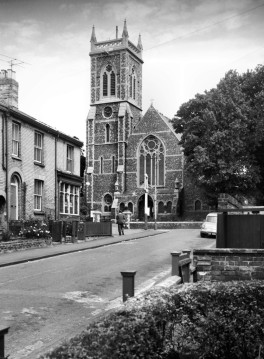 13th July, 1944. Evacuees from
the London area, taking refuge from the flying-bomb
menace, commenced to arrive in Norfolk. About 20,000
arrived in the space of three days. 13th July, 1944. Evacuees from
the London area, taking refuge from the flying-bomb
menace, commenced to arrive in Norfolk. About 20,000
arrived in the space of three days.8th September, 1944. Further
evacuees arrived in Norwich.
September and October
1944. During these two months the rocket-bombs
fell in Norfolk. Although one or two fell very close to
Norwich (notably on the golf course at Lower Hellesdon)
none fell within the city boundary. Statistics in regard
to this type of weapon (as far as the county was
concerned) show that four were the most to fall in any
one day, and the worst incident caused was at Rockland St
Mary where twenty-one children and a woman were injured.
24th November, 1944.
Whilst returning to its base in difficulties, an American
plane flew low over the city during the afternoon. Its
wing-tip struck the tower of St Philip's Church
in Heigham Road (left) causing slight structural
damage to the building but sufficiently upsetting the
craft to cause it to crash. As his last act the pilot
managed to manoeuvre the machine so that it avoided a row
of houses in Heigham Street and landed instead on some
vacant ground near the railway. All the crew were killed.
A bronze plaque to commemorate their gallantry was
affixed to the houses so nearly destroyed and was
unveiled by General E.C.Kiel, Commanding General of the
8th Fighter Command, U.S.A. Air Force in November 1945.
|
 Throughout the
period of the war the eleven city sirens sounded no less
than 1,488 alerts, the first being sounded on the first
day of the war and the last on the 27th March, 1945. The
total amount of time taken up was 1,887 hours 51 minutes,
or 79 days. Throughout the
period of the war the eleven city sirens sounded no less
than 1,488 alerts, the first being sounded on the first
day of the war and the last on the 27th March, 1945. The
total amount of time taken up was 1,887 hours 51 minutes,
or 79 days.The Norwich air-raid casualty list amounted
to 340 killed and 1,092 seriously injured. A total of 681
high explosive bombs were dropped within the city
boundary during the war.
Information concerning the amount of repair work which
was necessitated by these raids was contained in a
detailed report made by the City Engineer to the Housing
Committee of the Corporation and the following summary
appeared in the Norfolk News dated January 6th,
1945:
|
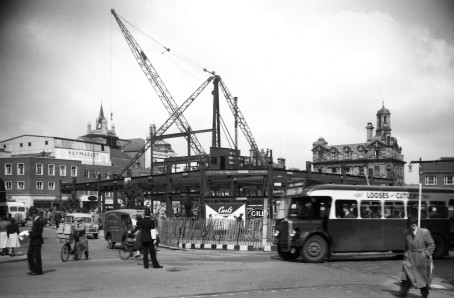 "The
first air raid on Norwich was on July 9th, 1940 and
subsequently up to April 1942 there were other small or
single-plane raids of a similar character which
occasioned damage to houses, the maximum at any one time
being 360. The repair work caused by these raids was
carried out by the Corporation without outside help. The
much heavier raids in April 1942 however, necessitated
help being brought in from other parts of the county and
further afield. A fairly elaborate organisation to
operate the repair work had been prepared by the City
Engineer well in advance and this generally proved
successful in spite of exceptionally difficult
circumstances caused by the loss of the Corporation's
central depot and stores at Westwick Street. "The
first air raid on Norwich was on July 9th, 1940 and
subsequently up to April 1942 there were other small or
single-plane raids of a similar character which
occasioned damage to houses, the maximum at any one time
being 360. The repair work caused by these raids was
carried out by the Corporation without outside help. The
much heavier raids in April 1942 however, necessitated
help being brought in from other parts of the county and
further afield. A fairly elaborate organisation to
operate the repair work had been prepared by the City
Engineer well in advance and this generally proved
successful in spite of exceptionally difficult
circumstances caused by the loss of the Corporation's
central depot and stores at Westwick Street."Materials were supplied by the Corporation
through central stores which operated for some time from
sheds and other temporary buildings set up at the Barker
Street Depot. For distribution purposes sub-stores were
set up in houses in various parts of the city and were
staffed by workmen who carried out their task with
considerable success. At one time over 160 contractors
were operating in the city and under the terms of the
contract had to be paid weekly.
"The total cost of the work
occasioned by all raids during April 1942 and since was
approximately £1,060,000 of which £280,000 was for
materials and haulage. Other work, such as repairs to
roads and sewers, was carried out by the City Engineer's
department as well as over 2000 removals of furniture,
whilst 850 loads of furniture were stored.
|
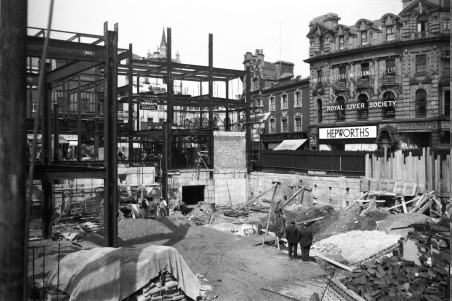 "The
following statistics tell their own story: -
Dwelling-houses - Totally destroyed 358; not repairable
1678; badly damaged, vacated, repairable 1158; badly
damaged but habitable 1539; moderate damage 25,621; total
30,354. "The
following statistics tell their own story: -
Dwelling-houses - Totally destroyed 358; not repairable
1678; badly damaged, vacated, repairable 1158; badly
damaged but habitable 1539; moderate damage 25,621; total
30,354."Industrial
Establishments, offices and business premises and public
buildings - Totally destroyed 80; not repairable 129;
badly damaged but repairable 258; moderate damage 508;
total 975.
"First-aid repairs were carried
out to 29,398 houses, this figure including 3511 houses
damaged a second time, and 144 damaged a third time. More
substantial repairs were carried out to 24,811 houses. Of
the 2697 badly damaged houses the local authority has
repaired 2326 and 228 have been or are being repaired
privately.
|
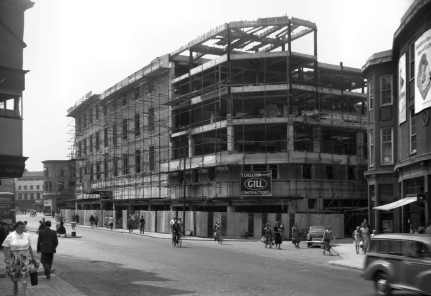 "All
available Corporation employees were engaged on the work
augmented by men from 68 different builders, contractors
and maintenance staffs of industrial firms in the city,
42 country firms, 28 Yarmouth contractors and 24 London
contractors. The special repair service of the Ministry
of Works also sent down a squad of men, the biggest
number being 500 in May 1942. The average number of men
employed from the blitz to the end of 1942 was
1530 per day. The greatest number employed was during May
1942 when 2001 were employed on a single day. "All
available Corporation employees were engaged on the work
augmented by men from 68 different builders, contractors
and maintenance staffs of industrial firms in the city,
42 country firms, 28 Yarmouth contractors and 24 London
contractors. The special repair service of the Ministry
of Works also sent down a squad of men, the biggest
number being 500 in May 1942. The average number of men
employed from the blitz to the end of 1942 was
1530 per day. The greatest number employed was during May
1942 when 2001 were employed on a single day."Repairs were done to 23,450 ceilings, 2300
chimney stacks and 19,850 doors and window frames. Glass
used to repair windows totalled 610,000 superficial
feet."
Photos: post-war
reconstruction of Orford Place
Curls (Debenhams) Department Store, 1953-55
|
 As already
mentioned the period of quiescence which commenced in the
middle of 1941 was rudely shattered on April 27th of the
following year by the first of the several blitz
raids which the city was to endure. The second followed
in rapid succession two nights later, with a third on
June 27th and a fourth on August 2nd. Incendiary bombs
accounted for a large proportion of the damage done
during the latter occasions. The total number of
casualties for the year amounted to over 250 killed and
many hundreds injured to a greater or less degree.
As already
mentioned the period of quiescence which commenced in the
middle of 1941 was rudely shattered on April 27th of the
following year by the first of the several blitz
raids which the city was to endure. The second followed
in rapid succession two nights later, with a third on
June 27th and a fourth on August 2nd. Incendiary bombs
accounted for a large proportion of the damage done
during the latter occasions. The total number of
casualties for the year amounted to over 250 killed and
many hundreds injured to a greater or less degree. Unfortunately,
for the same reason (and also no doubt because of the
long preceding period of quiescence) casualties were
heavy, 162 being killed (including firewatchers,
ambulance men and a Home Guard) with over 400 people
being injured.
Unfortunately,
for the same reason (and also no doubt because of the
long preceding period of quiescence) casualties were
heavy, 162 being killed (including firewatchers,
ambulance men and a Home Guard) with over 400 people
being injured. Much of St
Augustine's School was wrecked; the Norwich Institution
for the Blind was damaged by the same stick of bombs
which wrecked the roof of the Odeon Cinema in Botolph
Street. The Public Assistance Institution on Bowthorpe
Road received direct hits from both high explosives and
incendiaries, but many of the inmates were in the shelter
at the time and unhurt.
Much of St
Augustine's School was wrecked; the Norwich Institution
for the Blind was damaged by the same stick of bombs
which wrecked the roof of the Odeon Cinema in Botolph
Street. The Public Assistance Institution on Bowthorpe
Road received direct hits from both high explosives and
incendiaries, but many of the inmates were in the shelter
at the time and unhurt. At a number of
points digging was proceeding for trapped people and many
families, soot-covered but free of injury, were rescuing
what they could of their belongings. It has been
estimated that 185 heavy bombs of a total weight of over
50 tons were dropped on this occasion.
At a number of
points digging was proceeding for trapped people and many
families, soot-covered but free of injury, were rescuing
what they could of their belongings. It has been
estimated that 185 heavy bombs of a total weight of over
50 tons were dropped on this occasion. Part of St
Stephen's Street with the famous old Boar's Head
inn (left), Barwell's, Peacock's, and beyond
that several of the large factory buildings of Caley's
were also involved.
Part of St
Stephen's Street with the famous old Boar's Head
inn (left), Barwell's, Peacock's, and beyond
that several of the large factory buildings of Caley's
were also involved. Amongst the
other losses of the 27th and 29th April were the churches
of St Bartholomew in Heigham (right)
and St Benedicts (below); and parts of Oak St, Pitt St, St George's St, Gildencroft, St Benedict's St, Wellington Lane and Westwick St.
Amongst the
other losses of the 27th and 29th April were the churches
of St Bartholomew in Heigham (right)
and St Benedicts (below); and parts of Oak St, Pitt St, St George's St, Gildencroft, St Benedict's St, Wellington Lane and Westwick St. On 26th May,
1942 a visit to Norwich was paid by the Duke of Kent who
made an extensive tour of the damaged areas. He visited
the Norfolk and Norwich Hospital where he talked to
several victims and also the Norwich Institution for the
Blind. The tour began with an inspection in front of the
City Hall of members of the Home Guard, and Civil Defence
Workers. Subsequently the Lord Mayor (Mr J.H.Barnes)
received a letter from the Duke expressing his sorrow at
the extensive nature of the damage suffered by the city,
but stating how he had been impressed by the courage and
fortitude of the inhabitants in such difficult times.
On 26th May,
1942 a visit to Norwich was paid by the Duke of Kent who
made an extensive tour of the damaged areas. He visited
the Norfolk and Norwich Hospital where he talked to
several victims and also the Norwich Institution for the
Blind. The tour began with an inspection in front of the
City Hall of members of the Home Guard, and Civil Defence
Workers. Subsequently the Lord Mayor (Mr J.H.Barnes)
received a letter from the Duke expressing his sorrow at
the extensive nature of the damage suffered by the city,
but stating how he had been impressed by the courage and
fortitude of the inhabitants in such difficult times. 27th June, 1942. Three enemy
aircraft were destroyed when a small number of planes
crossed the east coast in the moonlight of the early
morning to attack Norwich for about an hour. Flares lit
up the sky and incendiaries and high explosives were
dropped which started several big fires.
27th June, 1942. Three enemy
aircraft were destroyed when a small number of planes
crossed the east coast in the moonlight of the early
morning to attack Norwich for about an hour. Flares lit
up the sky and incendiaries and high explosives were
dropped which started several big fires. A
determined attack was made upon the Cathedral, around
which no less than 850 incendiaries were showered, but
owing to the efforts of the firewatchers and to the fact
that the whole of the inside roofing is a vault of brick
and stone, the only damage suffered here was to the roofs
of the north and south transepts where some of the lead
was melted and the timbers burnt. Two or three old houses
in The Close were
gutted however, including the Audit Chamber and one of
the Grammar School blocks.
A
determined attack was made upon the Cathedral, around
which no less than 850 incendiaries were showered, but
owing to the efforts of the firewatchers and to the fact
that the whole of the inside roofing is a vault of brick
and stone, the only damage suffered here was to the roofs
of the north and south transepts where some of the lead
was melted and the timbers burnt. Two or three old houses
in The Close were
gutted however, including the Audit Chamber and one of
the Grammar School blocks. St Mary's Plain
Baptist Church, which was accidentally burned a few days
after the beginning of the war and had since been
restored, was again gutted - this time hopelessly so, and
with its adjoining schoolrooms; and similar fates were
suffered by the sacristy of St George's Roman Catholic
Church in Fishergate; by the Trinity Presbyterian
Church in Theatre Street (right); and the
Synagogue in the street of that name.
St Mary's Plain
Baptist Church, which was accidentally burned a few days
after the beginning of the war and had since been
restored, was again gutted - this time hopelessly so, and
with its adjoining schoolrooms; and similar fates were
suffered by the sacristy of St George's Roman Catholic
Church in Fishergate; by the Trinity Presbyterian
Church in Theatre Street (right); and the
Synagogue in the street of that name. In addition to
all this, extensive damage to houses and business
premises was caused (a total of 34 high explosives and
literally thousands of incendiaries were dropped during
the raid) but casualties were fortunately comparatively
light - sixteen people being killed and fifteen seriously
injured. Some of the raiders narrowly missed the
housetops in diving to their objectives; there was heavy
anti-aircraft fire and night fighters were busy.
In addition to
all this, extensive damage to houses and business
premises was caused (a total of 34 high explosives and
literally thousands of incendiaries were dropped during
the raid) but casualties were fortunately comparatively
light - sixteen people being killed and fifteen seriously
injured. Some of the raiders narrowly missed the
housetops in diving to their objectives; there was heavy
anti-aircraft fire and night fighters were busy.